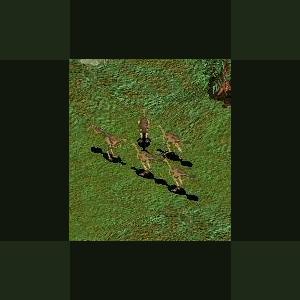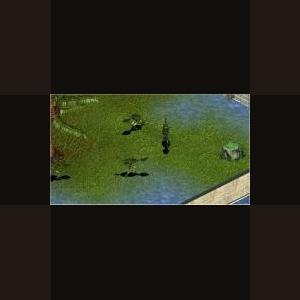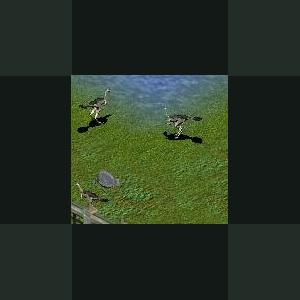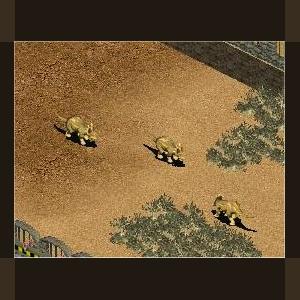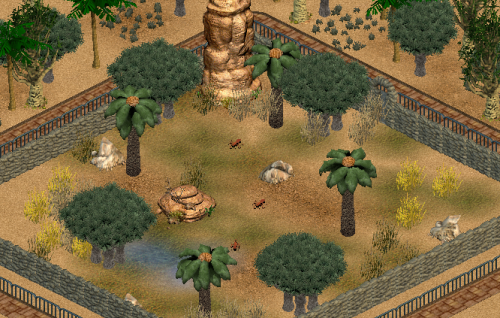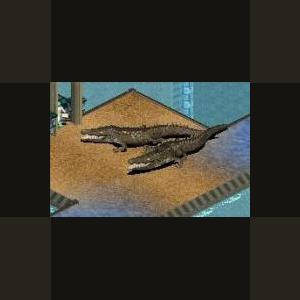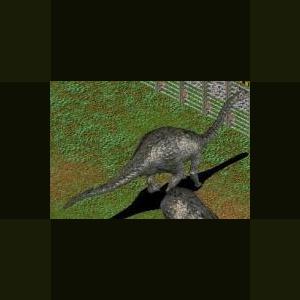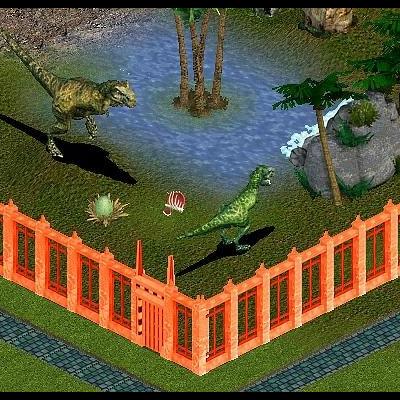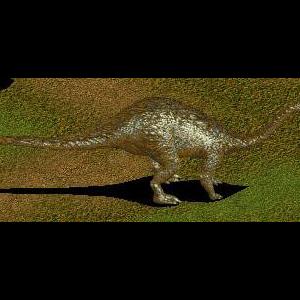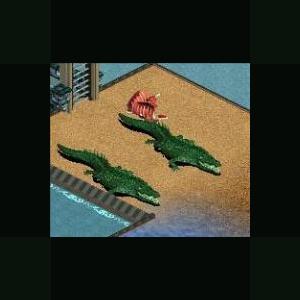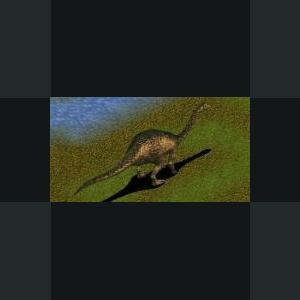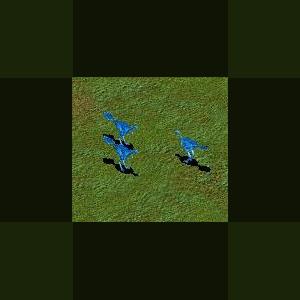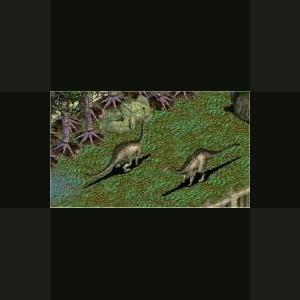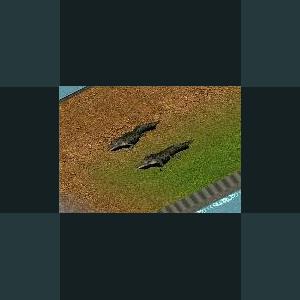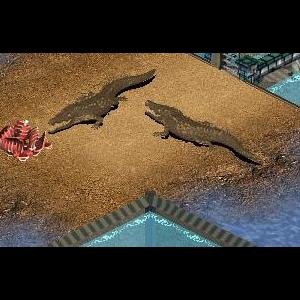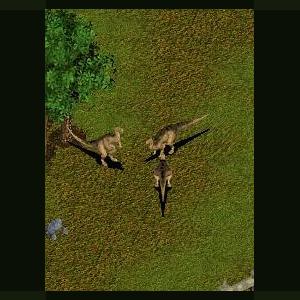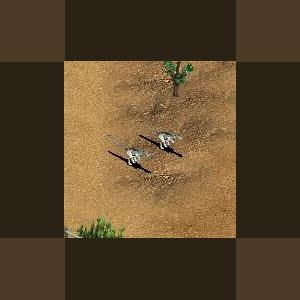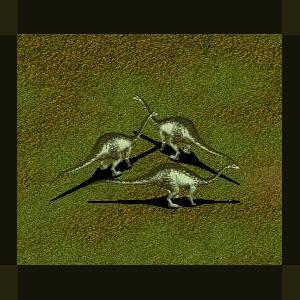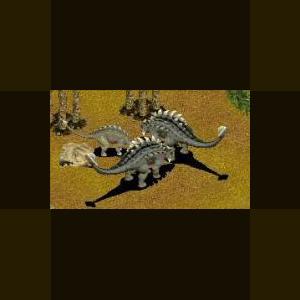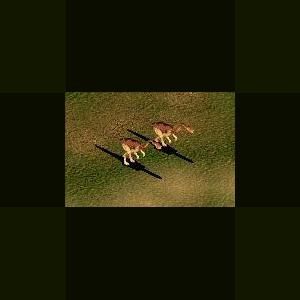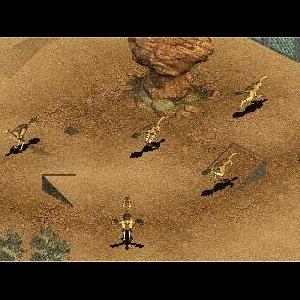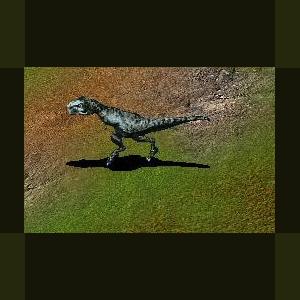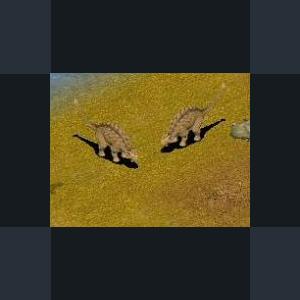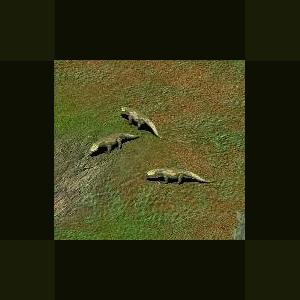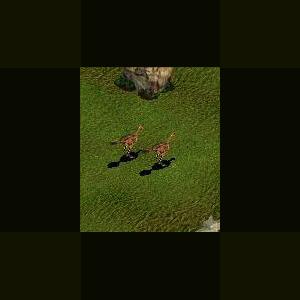Dinosaurs
Creatures from another age
241 files
-
Protarchaeopteryx by Moondawg
By Guest
Protarchaeopteryx
Protarchaeopteryx was a turkey-sized feathered dinosaur from China. Well-developed, vaned feathers extended from the short, stubby tail; the hands were long and slender, and had three-fingered clawed hands. It appears to be one of the most primitive members of the Oviraptorosauria and the large incisor teeth suggest that it is closely related to, or synonymous with, Incisivosaurus. It was probably an herbivore or omnivore, but its hands are very similar to small carnivorous dinosaurs.
Protarchaeopteryx, known from the Jianshangou bed of the Yixian Formation, lived in the early Aptian age of the Early Cretaceous, 124.6 million years ago. It is probably more primitive than Archaeopteryx, making it a non-avian theropod dinosaur rather than a true avian bird. At around 1 metre (3.3 ft) in length, it would have been larger than Archaeopteryx. Protarchaeopteryx had symmetrical feathers on its arms. Since modern birds that have symmetrical feathers are flightless, and the skeletal structure of Protarchaeopteryx would not support flapping flight, it is assumed that it was flightless as well.
204 downloads
0 comments
Updated
-
Protarcheopteryx by Ghirin
By Guest
Protarcheopteryx
Author: Ghirin
Protarcheopteryx ("Before Archeopteryx") was a feathered dinosaur from the Cretaceous lakeside environment of Liaoning, China. It was a contemporary of Caudipteryx.
196 downloads
0 comments
Updated
-
Protoavis by Moondawg
By Guest
Protoavis is claimed to have been a 35 cm tall bird that lived in what is now Texas, USA,
between 225 and 210 million years ago. Though it existed far earlier than Archaeopteryx,
its skeletal structure is allegedly more bird-like. Protoavis has been reconstructed as
a carnivorous bird that had teeth on the tip of its jaws and eyes located at the front of
the skull, suggesting a nocturnal or crepuscular lifestyle. The fossil bones are too bad
ly preserved to allow an estimate of flying ability; although reconstructions usually
show feathers (see link below), judging from thorough study of the fossil material there
is no indication that these were present (Paul, 2002; Witmer, 2002).
However, this description of Protoavis assumes that Protoavis actually existed and,
if so, that it has been reconstructed correctly. Almost all paleontologists doubt that
Protoavis is a bird, or even a good species, because of the circumstances of its
discovery, and unconvincing avian synapomorphies in its fragmentary material.
When they were found at a Dockum Formation quarry in the Texas panhandle in 1984,
in a sedimentary strata of a Triassic river delta, the fossils were a jumbled cache of
disarticulated dinosaur and other bones that may reflect an incident of mass mortality
following a flash flood.
The discoverer, Sankar Chatterjee of Texas Tech University, was convinced that some of
these crushed bones belonged to two individuals - one old, one young - of the same
species. However, only a few parts were found, primarily a skull and some limb bones
which moreover do not well agree in their proportions respective to each other, and this
has led many to believe that the Protoavis fossil is chimeric, made up of more than one
organism: the pieces of skull appear like those of a coelurosaur, while most parts of
the limb skeleton suggest affinities to ceratosaurs and at least some vertebrae are most
similar to those of Megalancosaurus[2], which despite what its name may suggest is not a
dinosaur but rather an avicephalan diapsid:
"Everywhere one turns; the very fossils ascribed thereto challenge the validity of
Protoavis. The most parsimonious conclusion to be inferred from these data is that
Chatterjee's contentious find is nothing more than a chimera, a morass of long-dead
archosaurs."
If it really existed, Protoavis would raise interesting questions about when birds
began to diverge from the dinosaurs, but until better evidence is produced, the
animal's status currently remains uncertain. Furthermore, paleobiogeography suggests
that birds did not colonize the Americas until the Cretaceous; the most primitive
lineages of unequivocal birds found to date are all Eurasian. Certainly, the fossils
are most parsimoniously attributed to primitive dinosaurian and other reptiles as
outlined above. However, coelurosaurs and ceratosaurs are in any case not too distantly
related to the ancestors of birds and in some aspects of the skeleton not unlike them,
explaining how their fossils could be mistaken as avian; Archaeopteryx itself was
initially believed to be a small theropod dinosaur. Zhonghe Zhou sums up the matter:
"[Protoavis] has neither been widely accepted nor seriously considered as a Triassic
bird [... Witmer], who has examined the material and is one of the few workers to
have seriously considered Chatterjee’s proposal, argued that the avian status of
P. texensis is probably not as clear as generally portrayed by Chatterjee, and
further recommended minimization of the role that Protoavis plays in the discussion
of avian ancestry."
Sometimes it is claimed that Protoavis is a refutation of the hypothesis that birds
evolved from dinosaurs. But this is not true; the only consequence would be to push
back the point of divergence further back in time and possibly cause the dromaeosaurs to
be included in the bird clade. Note that at the time when these claims were originally
made, the affiliation of birds and maniraptoran theropods which today is well-supported
and generally accepted by most ornithologists was much more contentious; most Mesozoic
birds have only been discovered since then. Note also that Chatterjee himself has used
Protoavis to support a close relationship between dinosaurs and birds.
"As there remains no compelling data to support the avian status of Protoavis or
taxonomic validity thereof, it seems mystifying that the matter should be so contentious.
The author very much agrees with Chiappe in arguing that at present, Protoavis is i
rrelevant to the phylogenetic reconstruction of Aves. While further material from the
Dockum beds may vindicate this peculiar archosaur, for the time being, the case for
Protoavis is non-existent
173 downloads
0 comments
Updated
-
Protoceratops by Ghirin
By Guest
Protoceratops ("Before the horned-faces") is well known from numerous skeletons, ranging from young animals to adults. It was a common dinosaur from Cretaceous Mongolia.
Reference:
The Illustrated Encyclopedia of Dinosaurs by Dougal Dixon. 2006
www.wikipedia.com
Created by Ghirin 2006
540 downloads
Updated
-
Protosolpuga by Serpyderpy
By Serpyderpy
Protosolpuga is an extinct species of solifugae known only from a single specimen that was discovered in Mazon Creek, Illinois, USA. While somewhat bigger than their real life size, these wonderful little creepy crawlies will make a nice addition to your paleozoic zoos!
102 downloads
0 comments
Updated
-
Purussaurus by Moondawg
By Guest
Purussaurus was a giant caiman living in South America, 20 million years ago (Miocene). It is only known from skull material found in Peruvian Amazonia.
The skull is about 1.5 meters (5 ft), and paleontologists estimate that the whole body would have measured around 15 meters (50 ft), which means that Purussaurus is one of the largest crocodilians known to have ever existed. Two other extinct crocodilians, Sarcosuchus and Deinosuchus, have similar proportions, but both are geologically much older, dating from the Early and Late Cretaceous, respectively. During the summer of 2005, a franco-peruvian expedition (the Fitzcarrald expedition) found new fossils of Purussaurus in Amazonia (600 km from Lima).
Purussaurus was a giant caiman living in South America during the Miocene epoch, 8 million years ago. It is known from skull material found in the Brazilian, Colombian and Peruvian Amazonia, besides in the north of Venezuela. The skull is about 1.5 meters (5 ft) long, and paleontologists estimate that the whole body would have measured around 12 meters, which means that Purussaurus is one of the largest crocodilians known to have ever existed. Two other extinct crocodilians, Sarcosuchus and Deinosuchus, have similar proportions, but both are geologically much older, dating from the Early and Late Cretaceous, respectively, and another from around the same era, the Rhamphosuchus, is also estimated to be of similar size. During the summer of 2005, a Franco-Peruvian expedition (the Fitzcarrald expedition) found new fossils of Purussaurus in Amazonia (600 km from Lima).
319 downloads
Updated
-
Quaesitosaurus by Moondawg
By Guest
Quaesitosaurus ('extraordinary lizard') is a Cretaceous titanosaurian sauropod (the last of this order) found by Kurzanov and Bannikov in 1983.
The type species is Quaesitosaurus orientalis. Quaesitosaurus grew to 23 meters long. It lived from 80 to 65 million years ago.
Quaesitosaurus (meaning "extraordinary lizard") is a genus of titanosaurian sauropod found by Kurzanov and Bannikov in 1983. The type species is Quaesitosaurus orientalis. Quaesitosaurus grew to 23 meters long. It lived from 85 to 70 million years ago during the Late Cretaceous (Santonian to Campanian ages). Its fossils, consisting solely of a partial skull, were found in the Barun Goyot Formation near Shar Tsav, Mongolia. Long, low and horse-like with frontally located peg-teeth, it is similar enough to the skulls of Diplodocus and its kin to have prompted informed speculation that the missing body was formed like those of diplodocids.
It is possible that Nemegtosaurus, also known from only skull material, is a very close relative of Quaesitosaurus, if not indeed a variation of the same animal.
140 downloads
0 comments
Updated
-
Rainforest T-Rex by JohnT
By Admin Uploader
The T-Rex loves plenty of fresh meat, and needs the strongest fence to hold it. This Rainforest Tyrannosaurus Rex uses the same graphics as the in-game T-Rex, but with a change in habitat and object preferences, as well as different animal info. Since this T-Rex links directly to the graphics of the in-game T-Rex, you must have either DD or CC to use it. The in-game T-Rex will still be available in addition to this T-Rex.
88 downloads
- dinosaur
- rainforest
- (and 1 more)
0 comments
Updated
-
Rapetosaurus by Moondawg
By Guest
Rapetosaurus
Rapetosaurus is a genus of sauropod dinosaur that lived in Madagascar from 70 to 65 million years ago, at the end of the Cretaceous Period. Only one species (R. krausei) has been identified.
Like other sauropods, Rapetosaurus was a quadrupedal herbivore; it is calculated to have reached lengths of 15 metres.
Rapetosaurus was a fairly typical sauropod, with a short and slender tail, a very long neck and a huge, elephant-like body. Its head resembles the head of a diplodocid, with a long, narrow snout and nostrils on the top of its skull. It was an herbivore and its small, pencil-like teeth were good for ripping the leaves off trees but not for chewing.
It was fairly modest in size, for a titanosaur. The juvenile specimen measured 8 metres (26 ft) from head to tail, and "probably weighed about as much as an elephant", according to Kristina Curry Rogers. An adult would have been about twice as long (15 meters (49 ft) in length) which is still less than half the length of its gigantic kin, like Argentinosaurus and Paralititan.
During the early part of the Late Cretaceous all groups of sauropods, with the exception of the titanosaurs had gone extinct. The titanosaurs were the dominant herbivores of the Late Cretaceous on the southern continents. Their reign was cut short by the Cretaceous-Tertiary extinction event, which killed almost all the dinosaurs about 65 million years ago.
The discovery of Rapetosaurus, known by the single species Rapetosaurus krausei (pronounced rah-PAY-too-SORE-us KROW-sie and meaning 'Krause's mischievous giant lizard') marked the first time a titanosaur had been recovered with an almost perfectly intact skeleton, complete with skull. It has helped to clarify some difficult, century-old classification issues, among this large group of sauropod dinosaurs and provides a good baseline for the reconstruction of other titanosaurs that are known only from partial fossilized remains.
The discovery was published in 2001 by Kristina Curry Rogers and Catherine A. Forster in the scientific journal Nature. The nearly-complete skeleton is that of a juvenile and partial remains from three other individuals were also recovered.
The titanosaurs are the largest group of sauropods but are poorly represented in the fossil record. Other groups of sauropods, even small families like the brachiosaurids, are known from more complete remains. Until the discovery of Rapetosaurus, the 30 or so genera were represented by just a few bones, a partial skeleton or a skull. The first titanosaur, discovered in 1887, is still only known from a partial skeleton.
This has made it difficult to determine not just the relationship between different genera of titanosaur but even how the titanosaurs are related to other, higher-level groups like the macronarians (the group of "big nostril" sauropods, which include the titanosaurs, the nemegosaurids and the brachiosaurids). The whole taxon has been used as a dumping ground, with many genera labeled as incertae sedis (belonging to an unknown group), because not enough is known about them to classify them any further.
The Diplodocus-like skull has demonstrated that titanosaur skulls vary more than was previously believed. Most paleontologists believed that titanosaurs had box-like skulls with the nostrils midway up the snout, like the Camarasaurus, but Rapetosaurus has a long, low skull, with the nostrils on the top, similar to Diplodocus. This has allowed genera known only by Diplodocus-like skulls (like Quaesitosaurus and Nemegtosaurus and other nemegtosaurids) to be classified as macronarians rather than in Diplodocoidea.
Analysis of the rest of the skull and the body has also confirmed what was only previous speculated: that titanosaurs are most closely related to the brachiosaurids. "The discovery of this dinosaur is particularly exciting because it confirms a close relationship between the titanosaurs and brachiosaurs, something that could only be surmised previously," according to Rich Lane, of the National Science Foundation.
A complete skeleton can also serve as a baseline when reconstructing other titanosaurs from limited remains. This is the basis for new, revised estimates of the size of the super-giant titanosaurs.
The new species, Rapetosaurus krausei, was described in the August 2, 2001 issue of the scientific journal Nature, by Kristina Curry Rogers (then a graduate student under Catherine Forster and now employed by Macalester College, in St. Paul, Minnesota) and Catherine A. Forster, an Associate Professor at the Department of Anatomical Sciences of the State University of New York at Stony Brook, in Stony Brook, New York.
The Rapetosaurus is a member of the Nemegtosauridae family, which is within the unranked Titanosauria taxon.
The Madagascar dig
"Only a few of the tail bones were missing."
—Kristina Curry Rogers
The dig uncovered a partial skull (UA 8698, the holotype specimen), another partial skull, a juvenile skeleton missing only a few tail vertebrae, and an unrelated vertebra. The juvenile skeleton, in particular, is the most complete titanosaur skeleton ever recovered and the only one with a head still attached to the body.
The fossilized remains were found in the Mahajanga basin in northwest Madagascar, not far from the port city of Mahajanga. They were recovered from a layer of sandstone known as the Anembalemba Member, which is part of the Maevarano Formation. The rock formation has been dated to the Maastrichtian stage of the late Cretaceous, which means the fossilized bones are about 70 million years old.
They were found by a field team from the State University of New York at Stony Brook with the assistance of the local Universite d'Antananarivo. The team leader, David Krause, had been excavating fossils from the site since 1993.
A treasure-trove of bone
"We dug into the hillside, and the more you dug, the more bones we found".
—Kristina Curry Rogers
The Madadgascar location has produced a large number of significant paleontological discoveries for Krause and his team. As well as dinosaurs, fossils of fishes, frogs, turtles, snakes, crocodiles, birds, and mammals have been unearthed. Significant finds include:
The skull of Majungasaurus, a large carnivorous theropod like Tyrannosaurus, was discovered in 1996. It is similar to species found in India and Argentina, which indicate that land bridges between the fragments of the former supercontinent of Gondwana still existed in the late Cretaceous, far later than was previously believed. The most likely occurrence was a land bridge allowing animals to cross from South America to Antarctica, and then up to India and Madagascar. (See also Polar dinosaurs in Australia.)
Majungasaurus fossils have also been discovered with teeth marks that clearly come from the same species, making it the first dinosaur known to have practiced cannibalism.
Masiakasaurus is a new species of theropod, with very unusual teeth that stick straight out from its jaw.
A single, 70 million year old marsupial tooth. Madagascar was separated by water when the marsupials first evolved in the northern hemisphere, and there are no current species of marsupial on the island, which has revived the idea that colonies of animals might have somehow crossed vast stretches of water.
http://en.wikipedia.org/wiki/Rapetosaurus
157 downloads
0 comments
Updated
-
Rhamphosuchus by Moondawg
By Guest
Rhamphosuchus ("Beak crocodile") is an extinct relative of the modern gharial and false gharial.
It inhabited what is now the Indian sub-continent in the Miocene and Pliocene eras. It is only known from incomplete sets of fossils, mostly teeth and skulls, but palaeontologists estimate that it was one of the largest, if not the largest crocodylian that ever lived, reaching an estimated length of 15 to 18 m (50-60 ft). Another crocodylian, Purussaurus from the same era but living in Brazil is estimated to be of similar size from an equally incomplete fossil set. The only other crocodylians which even come close are the Late Cretaceous Deinosuchus and Early Cretaceous Sarcosuchus and also the strange planctivorous Mourasuchus which lived at the same time and in the same region with Purussaurus. As a relation to the modern gharial, Rhamphosuchus almost certainly ate fish, but whether of not it was capable of killing larger animals is unknown.
221 downloads
0 comments
Updated
-
Rhoetosaurus by Moondawg
By Guest
Rhoetosaurus ("Rhoetos lizard"), named after Rhoetus, a Titan in Greek Mythology, was a genus of Sauropod dinosaur from the Jurassic (Middle Jurassic) of what is now eastern Australia.
Rhoetosaurus is estimated to have been about 12-15 metres long.
In 1924, Heber Longman, self-trained paleontologist at (and later director of) the Queensland Museum in Brisbane, learnt of a large fossil reptile skeleton exposed on Durham Downs Station near Roma in central Queensland. The station manager, Arthur Browne, forwarded fragments of bone to Longman, so and was honoured with the dinosaur's specific name brownei.
The initial collection was of 22 tail vertebrae, including a series of 16 consecutive bones, and other fragmentary hindlimb pieces. Soon after Longman announced the new discovery, he visited the station and arranged for more material of the same skeleton to be sent to the Queensland Museum. These included additional vertebrae from the thoracic area, bits of rib, more caudals and more of the femur and pelvis as well as a cervical vertebra.
Further material was collected by Mary Wade and Alan Bartholomai in 1975, and still more by Drs. Tom Rich, Anne Warren, Zhao Xijin, and Ralph Molnar. This additional material includes more ribs, another possible cervical vertebrae, and most of right hind limb, which is currently under study. To date, the end of the tail, forelimbs nor skull has not been found.
Along with Austrosaurus, Rhoetosaurus is among the two best-known sauropods thus far discovered in Australia, as well as for the Jurassic of Gondwana. Rhoetosaurus is presently the most complete Australian sauropod.
Inspired by the Zoo Tek Brains Trust
80 downloads
Updated
-
Rinchenia by Moondawg
By Guest
Rinchenia
Rinchenia was a genus of Mongolian oviraptorid dinosaur from the Late Cretaceous Period. Rinchenia mongoliensis was originally considered a species within the genus Oviraptor (named Oviraptor mongoliensis by Rinchen Barsbold in 1986), but a re-examination by Barsbold in 1997 found differences significant enough to warrant a separate genus. The name Rinchenia was coined for this new genus by Barsbold in 1997, though he did not describe it in detail, and the name remained a nomen nudum until used by Osmólska et al. in 2004.
Rinchenia is known from a single specimen (GI 100/32A) consisting of a complete skull and lower jaw, partial vertebral column, partial forelimbs and shoulder girdle, partial hind limbs and pelvis, and a furcula ("wishbone"). While Rinchenia was about the same size as Oviraptor (about 1.5 meters, or 5 ft long), several features of its skeleton, especially in the skull, show it to be distinct. It skeleton was more lightly built and less robust than that of Oviraptor, and while the crest of Oviraptor is indistinct because of poor fossil preservation, Rinchenia had a well-preserved, highly developed, dome-like casque which incorporated many bones in the skull that are free of the crest in Oviraptor.
191 downloads
0 comments
Updated
-
Riojasaurus by Ghirin
By Guest
Riojasaurus ("Rioja lizard") was a prosauropod dinosaur from Argentina. The remains were found in La Roja Province. It was a heavily built animal.
Reference:
www.wikipedia.org
Created by Ghirin 2008
151 downloads
0 comments
Updated
-
Rutiodon by Moondawg
By Guest
Rutiodon
Rutiodon is an extinct genus of archosaurian reptile belonging to the phytosaur (plant lizard) group of the Triassic era. It was up to 3 m long.
Like other phytosaurs, Rutiodon strongly resembled a crocodile, with the only exception being the fact that its nostrils were positioned close to the eyes. Because of its enlarged front teeth, it most closely resembled the gharial. It probably caught fish and also snatched land animals from the waterside.It was an ambush predator. The animal is known from fossils in Europe (Germany and Switzerland as well as North America (Arizona, New Mexico, North Carolina, Texas). Its tail was covered with armour.
212 downloads
0 comments
Updated
-
Sarcosuchus Imperator by Moondawg
By Guest
Sarcosuchus meaning 'flesh crocodile' and commonly called "SuperCroc", is an extinct genus of crocodile.
It dates from the early Cretaceous Period of what is now Africa and is one of the largest giant crocodile-like reptiles that ever lived. It was almost twice as long as the largest modern crocodile and weighed up to 10 times as much.
Until recently, all that was known of the genus was a few fossilised teeth and armour scutes, which were discovered in the Sahara Desert by the French paleontologist Albert-Félix de Lapparent, in the 1940s or 1950s. However, in 1997 and 2000, Paul Sereno discovered half a dozen new specimens, including one with about half the skeleton intact and most of the spine. All of the other giant crocodiles are known only from a few partial skulls, so which is actually the biggest is an open question.
When fully mature, Sarcosuchus is believed to have been as long as a city bus (11.2–12.2 meters or 37–40 ft) and weighed up to 8 tonnes (8.75 tons). The largest living crocodilian, the saltwater crocodile, is less than two-thirds of that length (6.3 meters or 20.6 ft is the longest confirmed individual) and a small fraction of the weight (1,200 kg, or 1.3 tons).
The very largest Sarcosuchus is believed to have been the oldest. Osteoderm growth rings taken from an 80% grown individual (based on comparison to largest individual found) suggest that Sarcosuchus kept growing throughout its entire 50–60 year average life span (Sereno et al., 2001). Modern crocodiles grow at a rapid rate, reaching their adult size in about a decade, then growing more slowly afterwards.
Its skull alone was as big as a human adult (1.78 m, or 5 ft 10 inches). The upper jaw overlapped the lower jaw, creating an overbite. The jaws were relatively narrow (especially in juveniles). The snout comprises about 75% of the skull's length (Sereno et al., 2001).
The huge jaw contained 132 thick teeth (Larsson said they were like "railroad spikes. The teeth were conical, adapted for grabbing and holding; instead of narrow, adapted for slashing (like the teeth of some land-dwelling carnivores), and more like that of true crocodilians. Sarcosuchus could probably exert a force of 80 kN (18,000 lbf) with its jaw, making it very unlikely that prey could escape.
It had a row of bony plates or osteoderms, running down its back, the largest of which were 1 m (3 ft) long. The scutes served as armour and may have helped support its great mass, but also restricted its flexibility.
Sarcosuchus also had a strange depression at the end of its snout. Called a bulla, it has been compared to the ghara seen in gharials. Unlike the ghara, though, the bulla is present in all Sarcosuchus skulls that have been found so far. This suggests it was not a sexually selected character (only the male gharial has a ghara). The purpose of this structure remains enigmatic. Sereno and others asked various reptile researchers what their thoughts on this bulla were. Opinions ranged from it being an olfactory enhancer to being connected to a vocalization device.
360 downloads
0 comments
Updated
-
Scelidosaurus by Moondawg
By Guest
Scelidosaurus
Scelidosaurus ( meaning "limb lizard", from Greek skelos meaning 'leg' and saurus meaning 'lizard') was a genus of quadrupedal, lightly plated, herbivorous dinosaur about 4 metres long. It lived during the Early Jurassic Period, during the Sinemurian to Hettangian stages around 194 to 208 million years ago. Its fossils have been found in both England and in Arizona, in the United States. Scelidosaurus has been called the earliest complete dinosaur. This genus and related genera have been found on three continents.
Comparative anatomist Richard Owen described Scelidosaurus in 1859. Only one species, S. harrisonii, is considered valid today, although other species have been proposed over the years. One of the most primitive of the thyreophorans, the exact placement of Scelidosaurus within the suborder has been the subject of debate for nearly 150 years. This is not helped by the paucity of knowledge about its closest relatives.
A full-grown Scelidosaurus was rather small, compared to most other dinosaurs. Some scientists have estimated a length of 4 metres (13 ft) Scelidosaurus was quadrupedal, with the hindlimbs considerably longer than the forelimbs. It may have reared up on its hind legs to browse on foliage from trees, but its forefeet were as large as its hind feet, indicating a mostly quadrupedal posture. Scelidosaurus had four toes, with the innermost digit being the smallestUnlike later ankylosaurs, the skull was low and triangular in shape, longer than it was wide, similar to that of primitive ornithischians. The head of Scelidosaurus was small, and it had a neck that was longer than that of most armored dinosaurs.
Like other thyreophorans, Scelidosaurus was herbivorous, with very small, leaf-shaped cheek teeth suitable for cropping vegetation. It is believed Scelidosaurus fed with a puncture-crush system of tooth-on-tooth action, with simple up-and-down jaw movement. Unlike later ankylosaurs, Scelidosaurus still had the five pairs of fenestrae (skull openings) seen in primitive ornithischians, and its teeth were more leaf-shaped than later armored dinosaurs
The most obvious feature of Scelidosaurus is its armor, consisting of bony scutes embedded in the skin. These osteoderms were arranged in parallel rows down the animal's body. Osteoderms are also found in the skin of crocodiles, armadillos and some lizards. These osteoderms ranged in both size and shape; most were small, flat plates, but thicker scutes also occurred. The scutes were aligned in regular horizontal rows down the animal's neck, back, and hips, with smaller scutes arranged on the limbs and tail. The lateral scutes were conical, rather than the blade-like osteoderms of Scutellosaurus, and have been used to identify the genus. It also had a pair of distinctive three-pointed scutes behind the head. Compared to later ankylosaurs, Scelidosaurus was lightly armored.
Fossilized skin impressions have also been found. Between the bony scutes, Scelidosaurus had rounded scales similar to those of a Gila monster. Between the large scutes, very small (5-10 millimetres [0.2-0.4 in]) flat "granules" of bone were distributed within the skin. In later ankylosaurs, these small scutes may have developed into larger scutes, fusing into the multi-osteodermal plate armor seen in genera such as Ankylosaurus.
Scelidosaurus and its Jurassic relatives were herbivorous. However, while other ornithischians possessed teeth capable of grinding plant material, Scelidosaurus had smaller, less complex teeth and a jaw capable of only simple up-and-down jaw movements. In this aspect, they resembled the stegosaurids, which also bore primitive teeth and simple jaws. Also like stegosaurs, they may have swallowed gastroliths to aid processing of food (because of the lack of chewing ability), in the same manner used by modern birds and crocodiles. Their diet would have consisted of leaved plants or fruits, as grasses did not evolve until late into the Cretaceous Period, after Scelidosaurus had become extinct.
Scelidosaurus was an ornithischian and has been classified at different times as an ankylosaur or stegosaur. This debate is still ongoing; at this time, it is considered to be either more closely related to ankylosaurids than to stegosaurids and, by extension, a true ankylosaur, or basal to the ankylosaur-stegosaur split. The stegosaur classifcation has fallen out of favor, but is seen in older dinosaur books. Despite its ankylosaur classification, Scelidosaurus shared similarities with Stegosaurus, including a heavy body highest at the hips and bony plates down its back.
Scelidosaurus gives its name to the Scelidosauridae, a group of primitive ornithischians close to the ancestry of ankylosaurs and stegosaurs. Aside from Scelidosaurus, other members of the clade include Bienosaurus and possibly Scutellosaurus. Originally proposed by Edward Drinker Cope in 1869, the family was resurrected by Chinese paleontologist Dong Zhiming in 2001 after study of Bienosaurus, which shares close affinities with Scelidosaurus. The scelidosaurids have been found in Early Jurassic formations, and may have persisted into the Late Jurassic. Their fossils have been found in China, England, and Arizona. Some paleontologists consider the Scelidosauridae paraphyletic, but Benton (2004) lists the group as monophyletic.
Fossil records of thyreophorans more basal than Scelidosaurus are sparse. The more primitive Scutellosaurus, also found in Arizona, was an earlier genus which was facultatively bipedal. A trackway of a possible early armoured dinosaur, from around 195 million years ago, has been found in France.[13] Ancestors of these primitive thyreophorans evolved from early ornithischians similar to Lesothosaurus during the Late Jurassic.
S. harrisonii, described by Owen, is currently the only recognized species, based on several nearly complete skeletons. A potential second species from the Sinemurian-age Lower Lufeng Formation, S. oehleri, was described by D.J. Simmons in 1965 under its own genus, Tatisaurus. In 1996 Spencer G. Lucas moved it to Scelidosaurus. Although the fossils are fragmentary, this reassessment has not been accepted, and S. oehleri is today once again recognized as Tatisaurus.
While James Harrison of Charmouth, England was quarrying the cliffs of Black Ven (between Charmouth and Lyme Regis), possibly for raw material for the manufacture of cement, in 1858, he found a few fragmentary fossils of limb bones. He sent them to Professor Richard Owen of the Natural History Museum (originally the British Museum (Natural History), London). These, with later finds from the same spot, revealed a nearly complete skeleton. Scelidosaurus was named by Sir Richard Owen in 1859; however, a complete description did not appear until 1863. Unfortunately, mixed in with the Scelidosaurus fossils were the partial remains of a theropod dinosaur; this was not discovered until 1968. In 1888, Richard Lydekker selected the knee joint as the lectotype of Scelidosaurus.
For many years, the enigmatic fossils of Scelidosaurus caused some debate over the classification of the genus. Von Zittel (1902), Swinton (1934), and Appleby et al. (1967) identified the genus as a stegosaur.[17] In a 1968 paper, Romer argued it was an ankylosaur. In 1977, Richard Thulborn of the University of Queensland attempted to reclassify Scelidosaurus as an ornithopod similar to Tenontosaurus or Iguanodon. Thulborn argued Scelidosaurus was a lightly-built bipedal dinosaur adapted for running. Thulborn's 1977 theories on the genus have since been rejected.
In 1968, B. H. Newman applied to have Lydekker's selection of the knee joint as the lectotype officially rescinded by the International Commission on Zoological Nomenclature, as the joint was from a megalosaur. Wells et al. informally reassigned these bones, consisting of a femur and partial tibia, to "Merosaurus" in 1995.
In 1989, scutes identified as belonging to Scelidosaurus, which were found in the Kayenta Formation (Glen Canyon Group) of northern Arizona, helped to determine the age of the strata was around 200 million years ago.] These scutes also established a geographic tie-in between Arizona's Glen Canyon and Europe, where fossils of Scelidosaurus had previously been discovered. Some scientists have disputed the assignment to Scelidosaurus, though.
In 2000, Martill et al. announced the preservation of soft tissue in a specimen of Scelidosaurus. These fossils consist of eight caudal vertebrae in a cut slab of carbonate mudstone, which was judged to date from the late Hettangian to Sinemurian stages. Parts of the fossil were preserved in such a way that an envelope of preserved soft tissue is visible around the vertebrae, and show the presence of an epidermal layer over the scutes. The authors concluded that the osteoderms of all basal armored dinosaurs were covered in a tough, probably keratinous layer of skin.
164 downloads
0 comments
Updated
-
Segisaurus by Moondawg
By Guest
Segisaurus
Segisaurus (meaning "Segi canyon lizard") was a small coelophysoid theropod dinosaur, that measured approximately 1 metre in length. The only known specimen was discovered in 1933 in early Jurassic strata in Tsegi Canyon, Arizona, for which it was named. Segisaurus is the only dinosaur to have ever been excavated from the area. It was later described in 1936 by the paleontologist Charles Lewis Camp. The fragmentary fossil skeleton consisted of portions of the limbs, pelvis, and vertebrae, but no cranial material was located. Segisaurus appears to have been closely related to the much more well-known Coelophysis. One distinction, however, was that Segisaurus had solid bones, while those of Coelophysis' were hollow. This even made some scientists consider if Segisaurus was even a theropod at all. Later investigations into the specimen's pelvic remains in 2005 lead scientists to believe that Segisaurus was in fact related more closely to Procompsognathus.
Segisaurus lived about 180 million years ago during the Jurassic period. Segisaurus was roughly the size of a goose and was a primitive bipedal theropod. Segisaurus was roughly 1 metre long, half a metre tall and weighed about 4-7 kilograms. It was nimble and insectivorous, although it may have scavenged meat also. It was bird-like in structure, with a flexible neck, elongated neck and a stubbish body. Segisaurus was three-toed and had powerful legs that were long compared to its body length. Like its legs, Segisaurus had a long tail and long forearms. Its collar bone was not unlike a bird's, thus strengthening scientists' arguments that dinosaurs were related to avians.
Segisaurus is described from the only specimen ever found. The holotype, however, was a sub-adult, so that the full size of Segisaurus as an adult may never be known. Strangely, clavicles were found on the Segisaurus specimen, which were unknown in other dinosaurs from that era.
The first discovery of Segisaurus was by Max Littlesalt, a Navajo Indian who kept livestock inside Tsegi Canyon. After discovering the remains, Littlesalt pointed out the fossils to archeologists on an expedition inside the canyon. Other than the first finding of Segisaurus, no other specimens have been discovered. After its initial description by Charles Lewis Camp, the holotype went relatively ignored for the next half century. When the specimen was investigated during this period, all who viewed it commented on the presence of clavicles and the solid bone structures the dinosaur had. According to recent reports, Segisaurus is vital in understanding the evolution of early theropods.
When the specimen of Segisaurus was discovered, Camp likened it to that of a "sitting hen", due to the position the dinosaur's remains were in. Other theropods used this positions to sleep or stay sheltered during large sand storms, and indeed the Segisaurus holotype was found in a bed of sand stone, suggesting that the dinosaur had been submerged in a layer of sand and died. This is still only a hypothesis, as no nest or den materials were discovered along the Segisaurus specimen. Another speculative interpretation from Camp has attracted less attention: that the "splint-like" neck ribs supported a Draco-like patagium along the neck, to improve the animal's ability to move quickly.
In September 2005, the Journal of Vertebrate Paleontology published a report which re-examined the remains of the Segisaurus holotype. The authors concluded, that although very unusual, Segisaurus was firmly a coelophysoid. They also noted that Segisaurus was probably a relative of Procompsognathus.
http://en.wikipedia.org/wiki/Segisaurus
164 downloads
0 comments
Updated
-
Sellosaurus by Moondawg
By Guest
Sellosaurus
Sellosaurus is the name given to a genus of prosauropod dinosaur that lived in Triassic Europe, 225 mya. Like other prosauropods, it had a thumb claw it may have used to defend itself, and reach for food.
Sellosaurus is one of the more well-known prosauropods. Over twenty skeletons have been discovered. These fossils comprise what is believed to be at least three separate species. The dinosaur Efraasia, a prosauropod from the same location, was long thought to be the same as Sellosaurus, but this has been recently disproved.
Sellosaurus is one of the more well-known prosauropods. Over twenty skeletons have been so far discovered. These fossils were found in strata dated to the middle Late Triassic and located in Nordwurttemberg, Germany. The remains comprise what is believed to be at least three separate species. The dinosaur Efraasia, a prosauropod from the same location, was long thought to be the same as Sellosaurus, but this has been recently disproved.
125 downloads
0 comments
Updated
-
Shamosaurus by Moondawg
By Guest
Shamosaurus is the name given to a genus of dinosaur from the Early Cretaceous. It was an ankylosaurid dinosaur from Mongolia.
Shamosaurus scutatus shares many cranial similarities with Gobisaurus domoculus, including a rounded squamosal, large elliptical orbital fenestrae and external nares, a deltoid dorsal profile with a narrow rostrum, quadratojugal protuberances, and caudolaterally directed paroccipital processes. But the two taxa may be distinguished by differences in the length of the maxillary tooth row, an unfused basipterygoid-pterygoid process in Gobisaurus, the presence on an elongate vomerine premaxillary process in Gobisaurus, and the presence of cranial sculpting in Shamosaurus, but not in Gobisaurus
145 downloads
0 comments
Updated
-
Shuvosaurus by Moondawg
By Guest
Shuvosaurus
Shuvosaurus (meaning "Shuvo's lizard") is a beaked reptile from the Late Triassic of Texas. It was described by Sankar Chatterjee in 1993 after it was discovered by his son Shuvo. It was initially interpreted as a Triassic member of the Cretaceous dinosaur family Ornithomimidae. However, the recent discovery of the related Effigia from Ghost Ranch shows that Shuvosaurus is more closely related to crocodilians, and that similarities between this animal and ornithomimids result from convergent evolution. Additionally, this discovery demonstrated that the taxon Chatterjeea was synonymous with Shuvosaurus.
126 downloads
0 comments
Updated
-
Shuvuuia by Ghirin
By Guest
Shuvuuia was a member of the bird-like alvarezsaurid group. A distinguishing feature of this group was the short arm ending in a large claw. This might be an adaptation for digging for food.
Reference:
The Illustrated Ecyclopedia of Dinosaurs by Dougal Dixon. 2006
www.wikipedia.com
Created by Ghirin 2006
250 downloads
0 comments
Updated
-
Siamotyrannus by Moondawg
By Guest
Siamotyrannus isanensis (meaning "Siamese Tyrant") was a carnosaur from the Early Cretaceous. Its fossils, the pelvis and vertebrae were found in Thailand. . As evidenced by its name, it was originally thought to be a tyrannosauroid, though it is quite small at 6.5m in length. It has also been suggested that it may be an allosaurid or sinraptorid.
* Inspired by the Zoo Tek Brains Trust
173 downloads
0 comments
Updated
-
Silvisaurus by Moondawg
By Guest
Silvisaurus, from the Latin silva "wood" and Greek saurus "lizard", is a nodosaurid ankylosaur from the middle Cretaceous of Kansas.
The holotype was recovered by T. H. Eaton from the University of Kansas from exposures of the Dakota Formation (late Aptian-early Cenomanian) in Kansas, and consists of an incomplete skeleton with skull and sacrum. To date, Silvisaurus includes only the type species, S. condrayi.
Based on these remains, the animal is estimated to have been approximately four meters in length (13 ft). Its skull measures 33 centimeters in length (13 in) and is 25 centimeters wide (10 in). The osseous secondary palate is poorly developed in Silvisaurus, the dentary includes at least twenty-five teeth, the basal tubera of the basiocciptial are bulbous, and each premaxilla holds eight to nine teeth. Besides the usual rounded and polygonal osteoderms, Silvisaurus may have also sported bony spines on its shoulders and tail.
This taxon represents a relatively primitive nodosaurid, and Vickaryous et al. (2004) have stated that "Sauropelta edwardsorum, Silvisaurus condrayi, and Pawpawsaurus campbelli form a basal polytomy nested deep to Cedarpelta."
146 downloads
0 comments
Updated
-
Simosuchus Clarki by Moondawg
By Guest
Simosuchus clarki
Simosuchus clarki ("Clark's Pug-nosed Crocodile") was a small crocodylomorph from the Early Cretaceous of Madagascar. It is named so for its unusually short skull. Fully grown individuals would have been about 1 meter in length.
S. clarki's teeth were shaped like cloves, or maple leaves, and, coupled with the proposterously short snout, were unsuitable for shearing or rending flesh. In fact, these features lead paleontologists to suspect that it was a (largely) terrestrial herbivore.
174 downloads
0 comments
Updated
-
Sinornithosaurus by Moondawg
By Guest
Sinornithosaurus (derived from a combination of Latin and Greek, meaning 'Chinese bird-lizard') is a genus of feathered dromaeosaurid dinosaur from the Lower Cretaceous Period (Middle Barremian) of the Yixian Formation in what is now China.
It caused a sensation because it was the fifth of the non - avian feathered dinosaur genera discovered by 1999. It was collected from the Sihetun locality of western Liaoning. It was in Layer 6, lower (Chaomidianzi) Yixian Formation, Jehol Group.
The holotype specimen is IVPP V12811, in the collection of the Institute of Vertebrate Paleontology and Paleoanthropology in Beijing, China. Another specimen, NGMC - 91, is probably a juvenile Sinornithosaurus. Qiang et al. (2001) were reluctant to name NGMC - 91 because, although the specimen is completely articulated, almost all of the bones shattered when the fossil slabs were split, so that only the silhouettes of theses bones are clear in most of the part and counterpart. This obscured diagnostic skeletal features, which made the specimen's genus uncertain. also called "Dave", is in the collection of the National Geological Museum of China. It was collected in Fanzhangzi quarry, near Lingyuan City, Liaoning Province, China. This is around 130km from the Sihetun locality. A specimen of the fish Lycoptera is also preserved near the foot of NGMC - 91.
Xu Xing described Sinornithosaurus and performed a phylogenetic analysis which demonstrates that it is basal, or primitive, among the dromaeosaurs.he has also demonstrated that features of the skull and shoulder are very similar to Archaeopteryx and other Avialae. Together these two facts demonstrate that the earliest dromaeosaurs were more like birds than the later dromaeosaurs were. This contradicts one argument made by critics of the theory that birds evolved from dinosaurs. See Temporal paradox (paleontology).
140 downloads
0 comments
Updated

